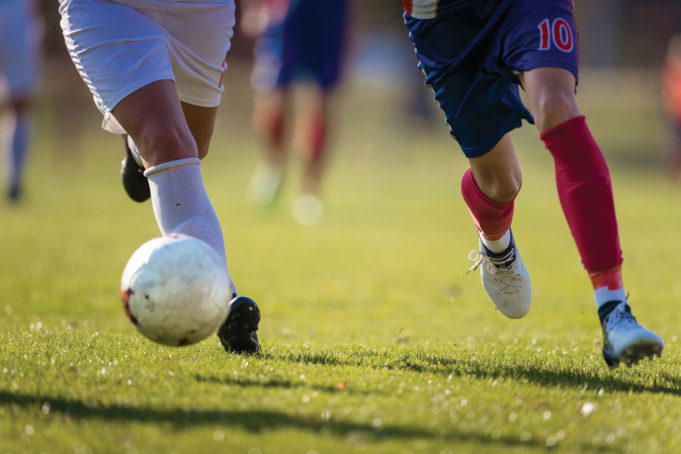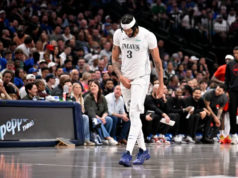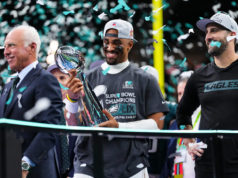The friendly match at AT&T Stadium notwithstanding (see: Night & Day), it’s time for the men to step aside, because the Women’s World Cup begins this week in France, with 24 nations competing to see who can call themselves world champions. Since my buddy G.P. Kennedy is busy watching the Cricket World Cup, that means that — oh, no! — I have to bring back my imaginary interlocutor to break down the tournament. Hello, idiot.
It’s great to be back! I’m interested in only one thing: How’s USA looking?
The defending champions are favorites again this time out. They’re ranked No. 1 in the world, with coach Jill Ellis changing to a 4-3-3 alignment. The forward line will look familiar, with 2015 veterans Megan Rapinoe and Tobin Heath pushed up alongside center forward Alex Morgan. (Meanwhile, the second unit, with 21-year-old sensation Mallory Pugh and ’15 vets Carli Lloyd and Christen Press, would be starting for most other countries.) Behind them, Julie Ertz (who was Julie Johnston four years ago) has converted from a central defender to a defensive midfielder and will act as a shield in front of the defense. Lindsey Horan will keep possession and distribute the ball, and Rose Lavelle will run around a lot.
Sounds like a high-level task.
It actually is an important job, because a midfield lacking in mobility can be overrun (unless they’re like Spain’s men between 2008 and 2012 and have a monopoly on the world’s best passers). Lavelle has skills to go with her stamina, being able to score the odd goal and even executing a scorpion kick in a pre-tournament friendly to set up a scoring chance.
So, USA is set for another trophy?
Not so fast. The defense has produced some worryingly shaky displays recently, and the biggest question mark is in goal. Hope Solo is gone, and while her teammates might not miss the off-field drama she always brought with her, they will miss her reliable presence in the net. Her replacement, Alyssa Naeher, projects as a middle-of-the-pack goalkeeper in this field. It’s true that average keepers can get hot and carry their team, but we also know that keepers are more affected by pressure than players at any other position and World Cup pressure is unique in the sport. We’ll have to see how Naeher deals. If she folds, that could open the door to another country.
Like who?
We need to start with France, the eternal bridesmaids who always seem to fall just short. They have home-field advantage, plus the chance to become the first-ever country to hold both the men’s and women’s soccer titles simultaneously. Les Bleues also have the personnel, especially down the middle: agile goalkeeper Sarah Bouhaddi, tiny goal-scoring threat Eugénie Le Sommer, creative playmaker Gaëtane Thiney, and central defender Wendie Renard and defensive midfielder Amandine Henry, both large, physical players who supplement their strength with tons of skill and reading of the game. If not France, then England look good for a title charge. They have experience at the back that includes arguably the world’s best fullback in Lucy Bronze, and their attacking threats Fran Kirby, Toni Duggan, and Nikita Parris are all potent.
Who else should we look out for?
Over in Group E, Canada has an experienced group that’s tough to break down, and Netherlands looks ready to make a deep run, with linchpin Lieke Martens and finisher Vivianne Miedema leading the offense. Spain may just have the stingiest defense in this field, and South Korea has Ji So-yon, their primary playmaker and scorer who’s in that zone where she gives her team a chance against anyone. Don’t sleep on Australia, either, with a seasoned group of players who are largely in their prime and Sam Kerr having blossomed into an elite scorer.
Who will disappoint?
Germany and Japan have come back to the pack but are still dangerous, between the former’s offensive firepower and the latter’s technically gifted midfield. My pick for this category is Brazil, which is aging and banged-up, with trouble spots all over the lineup. They have an easy group, but they’ll need Marta to find the Fountain of Youth to avoid a round of 16 exit.
Marta? Isn’t she a zillion years old?
No, she’s only 33, but injuries have diminished her significantly from the player who was as unstoppable as Lionel Messi in her prime. This is likely the last go-around for her and her 41-year-old teammate Formiga, who is playing in her seventh World Cup, a feat unmatched by any male or female player. Enjoy them while they’re here, along with Canada’s Christine Sinclair, who may well become the all-time leading woman scorer at this tournament.
Who will USA face in the group stages?
Chile has qualified for their first-ever Women’s World Cup, while Thailand has defied the odds and made it back for a second time. Neither team should give USA much of a problem, though Thailand’s Suchawadee Nildhamrong (a.k.a. Miranda Nild) is their best goal scorer and familiar with USA, since she’s currently playing for UC-Berkeley. Under the heading of We’ve Got to Stop Meeting Like This, there’s Sweden, which will face USA in the group stage for the fourth time in five World Cups. The U.S. women will also remember that the Swedes knocked them out on penalties in the 2016 Olympics. The Blågult have one of the world’s best keepers in Hedvig Lindahl and all-time great playmaker Caroline Seger, but strikers Sofia Jakobsson and Stina Blackstenius have been woeful, scoring fewer goals than the defenders on their team.
Ouch! What about the newcomers?
Besides Chile, Jamaica has also qualified for its first World Cup. Da Reggae Girlz jumped in after Mexico and Costa Rica fell off the pace in North American qualifying, and Khadija “Bunny” Shaw is a serious goal threat. Scotland is also the first “Home Country” besides England to make this tournament. They’re led by playmaker Kim Little and striker Jane Ross, and they’ll be drooling over their group-stage game against England. South Africa rounds out the debutantes, and they’re stuck in a group with Germany, China, and Spain. Anything other than a last-place finish will be a triumph for the Banyana Banyana.
Why is Europe’s leading scorer not here?
Ada Hegerberg plays for Olympique Lyonnais, which just finished steamrollering everyone in the Women’s Champions League. She is Norwegian and her country is competing in the tourney, but she has not played for Norway in the last two years over so-far-publicly-unspecified grievances with her national team and its treatment of women. She’ll be missed on the world stage, but her absence reminds us that the Jamaicans needed outside help (from Bob Marley’s daughter) to get basic gear, USA’s women are suing for equal pay, and England’s coach Phil Neville once bragged on Twitter about beating his wife. (He replaced Mark Sampson, a serial harasser who made racist jokes to his players’ faces.) Recently, women’s club matches have been pulling in NFL-sized crowds in Europe, but the struggle for recognition goes on all around the Women’s World Cup, not just on the pitch.













